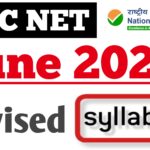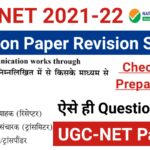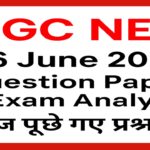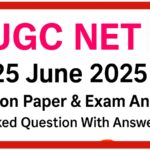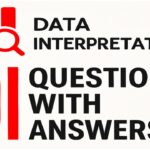Below is the list of MCQ & Some Important Question-Based UGC NET JRF Exam – Paper 1: Teaching Aptitude. For Practice please go through these Teaching & Research Aptitude Practice MCQ & Answers. This will help to understand the nature and pattern of question coming in the examination.
1. The main aim of teaching is [UGC NET December 2004]
(a) to develop only reasoning
(b) to develop only thinking.
(c) Both (a) and (b)
(d) to give information.
1. शिक्षण का मुख्य उद्देश्य है [ यूजीसी नेट दिसंबर 2004]
(ए) केवल तर्क विकसित करने के लिए
(बी) केवल सोच विकसित करने के लिए।
(सी) दोनों (ए) और (बी)
(डी) जानकारी देने के लिए।
2. The quality of teaching is reflected [UGC NET December 2004]
(a) by the attendance of students in the class.
(b) by the pass percentage of students.
(c) by the quality of questions asked by students.
(d) by the duration of silence maintained in the class.
2. शिक्षण की गुणवत्ता परिलक्षित होती है [यूजीसी नेट दिसंबर 2004]
(ए) कक्षा में छात्रों की उपस्थिति से।
(बी) छात्रों के उत्तीर्ण प्रतिशत से।
(सी) छात्रों द्वारा पूछे गए प्रश्नों की गुणवत्ता से।
(डी) कक्षा में मौन की अवधि के अनुसार।
3. Which of the following set of statements best describes the nature and objectives of teaching? [UGC NET July 2018]
Indicate your answer by selecting from the codes
1. Teaching and learning are integrally related.
2. There is no difference between teaching and training.
3. Concern of all teaching is to ensure some kind of transformation in students.
4. All good teaching is formal in nature.
5. A teacher is a senior person.
6. Teaching is a social act whereas learning is a personal act.
Codes:
(a) 1, 3 and 6
(b) 4, 5 and 6
(c) 1, 2 and 4
(d) 2, 3 and 5
3. निम्नलिखित में से कौन सा कथनों का सेट शिक्षण की प्रकृति और उद्देश्यों का सबसे अच्छा वर्णन करता है? [यूजीसी नेट जुलाई 2018]
कूटों में से चुनकर अपना उत्तर दें
1. अध्यापन और अधिगम अभिन्न रूप से संबंधित हैं।
2. शिक्षण और प्रशिक्षण में कोई अंतर नहीं है।
3. सभी शिक्षण की चिंता छात्रों में किसी प्रकार का परिवर्तन सुनिश्चित करना है।
4. सभी अच्छे शिक्षण प्रकृति में औपचारिक होते हैं।
5. एक शिक्षक एक वरिष्ठ व्यक्ति होता है।
6. शिक्षण एक सामाजिक कार्य है जबकि सीखना एक व्यक्तिगत कार्य है।
कोड:
(ए) 1, 3 और 6
(बी) 4, 5 और 6
(सी) 1, 2 और 4
(डी) 2, 3 और 5
4. “Education is the manifestation of perfection already in man” was stated by (UGC NET December 2014)
(a) M. K. Gandhi
(b) R. N. Tagore
(c) Swami Vivekanand
(d) Sri Aurobindo
4. “शिक्षा मनुष्य में पहले से ही पूर्णता की अभिव्यक्ति है” (यूजीसी नेट दिसंबर 2014) द्वारा कहा गया था।
(ए) एमके गांधी
(बी) आरएन टैगोर
(सी) स्वामी विवेकानंद
(डी) श्री अरबिंदो
5. Effective teaching is a function of (UGC NET December 2013)
(a) teacher’s satisfaction.
(b) teacher’s honesty and commitment.
(c) teacher’s making students learn and understand.
(d) teacher’s liking for professional excellence
5. प्रभावी शिक्षण (यूजीसी नेट दिसंबर 2013) का एक कार्य है।
(ए) शिक्षक की संतुष्टि।
(बी) शिक्षक की ईमानदारी और प्रतिबद्धता।
(सी) शिक्षक छात्रों को सीखते और समझते हैं।
(डी) पेशेवर उत्कृष्टता के लिए शिक्षक की पसंद
6. While delivering lecture if there is some disturbance in the class, a teacher should [UGC NET December 2013]
(a) keep quiet for a while and then continue.
(b) punish those causing disturbance.
(c) motivate to teach those causing disturbance.
(d) not bother of what is happening in the class.
6. कक्षा में कुछ गड़बड़ी होने पर व्याख्यान देते समय शिक्षक को चाहिए [यूजीसी नेट दिसंबर 2013]
(ए) थोड़ी देर चुप रहें और फिर जारी रखें।
(बी) अशांति पैदा करने वालों को दंडित करें।
(सी) अशांति पैदा करने वालों को सिखाने के लिए प्रेरित करें।
(डी) कक्षा में क्या हो रहा है, इसकी परवाह न करें।
7. A teacher in a classroom has immediate control over [UGC NET August 2016]
(a) the self, selected methods of communication and the message.
(b) the audience, the noise and the reception.
(c) the feedback, the technology and the audience experience.
(d) the communication channel, other communicators, and external factors.
7. कक्षा में एक शिक्षक का तत्काल नियंत्रण होता है [यूजीसी नेट अगस्त 2016]
(ए) स्वयं, संचार के चयनित तरीके और संदेश।
(बी) दर्शकों, शोर और स्वागत।
(सी) प्रतिक्रिया, प्रौद्योगिकी और दर्शकों का अनुभव।
(डी) संचार चैनल, अन्य संचारक, और बाहरी कारक।
8. Effective teaching comprises of
(a) an active teacher, but the students may be passive.
(b) active students, but the teacher may be passive.
(c) both the teacher and the students are active.
(d) All of the above
8. प्रभावी शिक्षण में शामिल हैं:
(ए) एक सक्रिय शिक्षक, लेकिन छात्र निष्क्रिय हो सकते हैं।
(बी) सक्रिय छात्र, लेकिन शिक्षक निष्क्रिय हो सकता है।
(सी) शिक्षक और छात्र दोनों सक्रिय हैं।
(D. उपरोक्त सभी
9. In a classroom, a communicator’s trust level is determined by [UGC NET December 2015]
(a) the use of hyperbole.
(b) the change of voice level.
(c) the use of abstract concepts.
(d) eye contact.
9. कक्षा में, एक संचारक का विश्वास स्तर [यूजीसी नेट दिसंबर 2015] द्वारा निर्धारित किया जाता है।
(ए) हाइपरबोले का उपयोग।
(बी) आवाज के स्तर में परिवर्तन।
(सी) अमूर्त अवधारणाओं का उपयोग।
(डी) आँख से संपर्क।
10. Which of the following qualities is most essential for a teacher? [UGC NET December 2011]
(a) He should be a learned person
(b) He should be a well-dressed person
(c) He should have patience
(d) He should be an expert in his subject
10. शिक्षक के लिए निम्नलिखित में से कौन सा गुण सबसे आवश्यक है? [यूजीसी नेट दिसंबर 2011]
(ए) वह एक विद्वान व्यक्ति होना चाहिए
(बी) वह एक अच्छी तरह से तैयार व्यक्ति होना चाहिए
(सी) उसे धैर्य रखना चाहिए
(डी) वह अपने विषय में एक विशेषज्ञ होना चाहिए
11. Suppose a student wants to share his problems with his teacher and he visits the teacher’s house for the purpose, the teacher should (UGC NET December 2011)
(a) contact the student’s parents and solve his problem
(b) suggest him that he should never visit his house
(c) suggest him to meet the principal and solve the problem
(d) extend reasonable help to boost his morale
11. मान लीजिए कि कोई छात्र अपनी समस्याओं को अपने शिक्षक के साथ साझा करना चाहता है और वह इस उद्देश्य के लिए शिक्षक के घर जाता है, शिक्षक को चाहिए (यूजीसी नेट दिसंबर 2011)
(ए) छात्र के माता-पिता से संपर्क करें और उसकी समस्या का समाधान करें
(बी) उसे सुझाव दें कि उसे अपने घर कभी नहीं जाना चाहिए
(सी) उसे प्रिंसिपल से मिलने और समस्या को हल करने का सुझाव दें
(डी) अपने मनोबल को बढ़ाने के लिए उचित सहायता प्रदान करें
12. On the first day of his class, if a teacher is asked by the students to introduce himself, he should [UGC NET June 2011]
(a) ask them to meet after the class
(b) tell them about himself in brief
(c) ignore the demand and start teaching
(d) scold the student for this unwanted demand
12. अपनी कक्षा के पहले दिन, यदि किसी शिक्षक को छात्रों द्वारा अपना परिचय देने के लिए कहा जाता है, तो उसे [UGC NET जून 2011]
(ए) उन्हें कक्षा के बाद मिलने के लिए कहें
(बी) उन्हें अपने बारे में संक्षेप में बताएं
(सी) मांग को अनदेखा करें और पढ़ाना शुरू करें
(डी) इस अवांछित मांग के लिए छात्र को डांटना
13. If the students do not understand what is taught in the class, the teacher should [UGC NET December 1997]
(a) repeat the lesson once again.
(b) teach the lesson again citing suitable examples.
(c) check the previous knowledge of the students in the topic.
(d) proceed to the next topic.
13. यदि छात्रों को समझ में नहीं आता है कि कक्षा में क्या पढ़ाया जाता है, तो शिक्षक को [यूजीसी नेट दिसंबर 1997]
(ए) पाठ को एक बार फिर से दोहराएं।
(बी) उपयुक्त उदाहरणों का हवाला देते हुए फिर से पाठ पढ़ाएं।
(सी) विषय में छात्रों के पिछले ज्ञान की जांच करें।
(डी) अगले विषय पर आगे बढ़ें।
14. The best way to react to a wrong answer given by a student is [UGC NET December 1997]
(a) to scold him for not having learnt the lesson.
(b) to explain why the answer is wrong.
(c) to ask another student to give the correct answer.
(d) to ignore the wrong answer and pass on the next question.
14. एक छात्र द्वारा दिए गए गलत उत्तर पर प्रतिक्रिया करने का सबसे अच्छा तरीका है [यूजीसी नेट दिसंबर 1997]
(ए) सबक न सीखने के लिए उसे डांटना।
(बी) यह समझाने के लिए कि उत्तर गलत क्यों है।
(c) दूसरे छात्र से सही उत्तर देने के लिए कहना।
(डी) गलत उत्तर को अनदेखा करने और अगले प्रश्न को पास करने के लिए।
15. The best educational program is the one which is framed keeping in mind the
(a) Need of the child
(b) Interest of the child
(c) Ability of the child
(d) Need of the society in addition to all these
15. सबसे अच्छा शैक्षिक कार्यक्रम वह है जिसे ध्यान में रखकर तैयार किया गया है
(ए) बच्चे की जरूरत
(बी) बच्चे की रुचि
(सी) बच्चे की क्षमता
(d) इन सब के अतिरिक्त समाज की आवश्यकता
16. If majority of the students in your class are weak, then as a teacher you should
(a) slow the pace of your teaching
(b) increase the pace so that students speed up
(c) focus only on intelligent students
(d) keep your teaching slow and give extra guidance to bright pupils
16. यदि आपकी कक्षा के अधिकांश विद्यार्थी कमजोर हैं, तो एक शिक्षक के रूप में आपको
(ए) अपने शिक्षण की गति को धीमा करें
(बी) गति बढ़ाएं ताकि छात्र गति बढ़ा सकें
(सी) केवल बुद्धिमान छात्रों पर ध्यान केंद्रित करें
(डी) अपने शिक्षण को धीमा रखें और उज्ज्वल विद्यार्थियों को अतिरिक्त मार्गदर्शन दें
17. To stop the mal-practice of cheating in the examinations, what step should be taken by the teacher?
(a) Punish the students as well as the parents
(b) Rusticate the student from the institution
(c) Explain the moral values attached to the event
(d) Severely punish the student
17. परीक्षाओं में नकल की कदाचार को रोकने के लिए शिक्षक को क्या कदम उठाने चाहिए?
(ए) छात्रों के साथ-साथ माता-पिता को भी दंडित करें
(बी) संस्थान से छात्र को रस्टीकेट करें
(सी) घटना से जुड़े नैतिक मूल्यों की व्याख्या करें
(डी) छात्र को कड़ी सजा देना
18. As a good classroom communicator, you are supposed to know your [UGC NET August 2016]
(a) audience emotions
(b) silent cues
(c) artful pauses
(d) counter arguments
१८. एक अच्छे कक्षा संचारक के रूप में, आपको अपने [यूजीसी नेट अगस्त २०१६] के बारे में पता होना चाहिए।
(ए) दर्शकों की भावनाएं
(बी) मूक संकेत
(सी) कलात्मक विराम
(डी) काउंटर तर्क
19. What is more desirable in a classroom? [UGC NET December 2000]
(a) A teacher delivering a lecture on the basis of the text and his own research.
(b) A teacher delivering a lecture on the basis of course content and standard books.
(c) A teacher answering questions raised by students.
(d) A teacher maintaining strict discipline and taking attendance regularly.
19. कक्षा में अधिक वांछनीय क्या है? [यूजीसी नेट दिसंबर 2000]
(ए) पाठ और अपने स्वयं के शोध के आधार पर व्याख्यान देने वाला शिक्षक।
(बी) पाठ्यक्रम सामग्री और मानक पुस्तकों के आधार पर व्याख्यान देने वाला शिक्षक।
(सी) छात्रों द्वारा उठाए गए सवालों का जवाब देने वाला शिक्षक।
(डी) एक शिक्षक सख्त अनुशासन बनाए रखता है और नियमित रूप से उपस्थिति लेता है।
20. While presenting your ideas in a classroom it is better to [UGC NET December 2000]
I. Recognise that there can be other views
II. Recognise that students are not a homogenous mass
III. Take dissenting views also in consideration
(a) Both I and III
(b) Only III
(c) Only II and III
(d) II and III
20. कक्षा में अपने विचार प्रस्तुत करते समय यह बेहतर है [यूजीसी नेट दिसंबर 2000]
I. पहचानें कि अन्य विचार भी हो सकते हैं
द्वितीय. पहचानें कि छात्र एक समरूप द्रव्यमान नहीं हैं
III. असहमति के विचारों को भी ध्यान में रखें
(ए) I और III दोनों
(बी) केवल III
(सी) केवल द्वितीय और तृतीय
(डी) द्वितीय और तृतीय
21. The most important challenge before a teacher is [UGC NET June 1997]
(a) to maintain discipline in the class.
(b) to make students do their homework.
(c) to prepare question paper.
(d) to make teaching-learning process enjoyable.
21. एक शिक्षक के सामने सबसे महत्वपूर्ण चुनौती है [UGC NET जून 1997]
(ए) कक्षा में अनुशासन बनाए रखने के लिए।
(बी) छात्रों को अपना होमवर्क करने के लिए।
(सी) प्रश्न पत्र तैयार करने के लिए।
(डी) शिक्षण-सीखने की प्रक्रिया को सुखद बनाने के लिए।
22. The basic requirement to teach efficiently is.
(a) mastery over the topic
(b) mastery over different strategies of teaching
(c) mastery over technology
(d) All of the above
22. कुशलता से पढ़ाने के लिए बुनियादी आवश्यकता है।
(ए) विषय पर महारत
(बी) शिक्षण की विभिन्न रणनीतियों पर महारत हासिल करना
(सी) प्रौद्योगिकी पर महारत
(D. उपरोक्त सभी
23. One of the most powerful affecting teaching effectiveness is related to the [UGC NET January 2011]
(a) social system of the country.
(b) economic status of the society.
(c) prevailing political system.
(d) educational system.
23. शिक्षण प्रभावशीलता को प्रभावित करने वाले सबसे शक्तिशाली में से एक [यूजीसी नेट जनवरी 2011] से संबंधित है।
(ए) देश की सामाजिक व्यवस्था।
(बी) समाज की आर्थिक स्थिति।
(सी) प्रचलित राजनीतिक व्यवस्था।
(डी) शैक्षिक प्रणाली।
24. From the list given below identify the learned characteristics which would facilitate teaching-learning system to become effective.
Choose the correct code to indicate your answer. [UGC NET November 2017]
I. Prior experience of learner
II. Learner’s family lineage
III. Aptitude of the learner
IV. Learner’s stage of development
V. Learner’s food habits and hobbies
VI. Learner’s religious affiliation Codes:
(a) IV, V and VI
(b) I, IV and V
(c) IL, III and VI
(d) II, III and IV
24. नीचे दी गई सूची से उन सीखी हुई विशेषताओं की पहचान करें जो शिक्षण-अधिगम प्रणाली को प्रभावी बनाने में सुविधा प्रदान करेंगी।
अपना उत्तर दर्शाने के लिए सही कोड चुनें। [यूजीसी नेट नवंबर 2017]
I. शिक्षार्थी का पूर्व अनुभव
द्वितीय. शिक्षार्थी का परिवार वंश
III. शिक्षार्थी की योग्यता
चतुर्थ। शिक्षार्थी के विकास की अवस्था
V. शिक्षार्थी की खाने की आदतें और शौक
VI. शिक्षार्थी की धार्मिक संबद्धता
(ए) चतुर्थ, वी और VI
(बी) मैं, चतुर्थ और वी
(सी) आईएल, III और VI
(डी) द्वितीय, तृतीय और चतुर्थ
25. Below are given a number of key behaviours as well as helpful behaviours of effectiveness of teaching based on research evidence.
Identify those which are key behaviours and indicate your answer by selecting from the code.
I. Structuring through comments by the teacher in respect of what is to come.
II. Questioning through content and process level questions.
III. Lesson clarity implying the extent to which presentations are not involved.
IV. Probing which implies statements to encourage students to elaborate.
V. Engagement rate devoted to learning when students are actually on task.
VI. Rate at which students understand and correctly comprehend assignments and exercises. [UGC NET December 2018]
Codes:
(a) II, III and IV
(b) I, FV and V
(c) I, IV and VI
(d) XIII, V and VI
25. नीचे अनुसंधान साक्ष्य के आधार पर कई प्रमुख व्यवहारों के साथ-साथ शिक्षण की प्रभावशीलता के सहायक व्यवहार दिए गए हैं।
उन लोगों की पहचान करें जो प्रमुख व्यवहार हैं और कोड से चयन करके अपना उत्तर इंगित करें। https://googleads.g.doubleclick.net/pagead/ads?client=ca-pub-5873471723252218&output=html&h=280&adk=356695841&adf=1056926812&pi=t.aa~a.3588669854~i.279~rp.4&w=712&fwrn=4&fwrnh=100&lmt=1625126926&num_ads=1&rafmt=1&armr=3&sem=mc&pwprc=9604728323&tp=site_kit&psa=1&ad_type=text_image&format=712×280&url=https%3A%2F%2Feasynotes4uonlinestudy.in%2Fugc-net-2021-important-questions-for-paper-1-teaching-and-research-aptitude%2F&flash=0&fwr=0&pra=3&rh=178&rw=711&rpe=1&resp_fmts=3&wgl=1&fa=27&uach=WyJXaW5kb3dzIiwiMTAuMCIsIng4NiIsIiIsIjkxLjAuNDQ3Mi4xMjQiLFtdLG51bGwsbnVsbCxudWxsXQ..&tt_state=W3siaXNzdWVyT3JpZ2luIjoiaHR0cHM6Ly9hZHNlcnZpY2UuZ29vZ2xlLmNvbSIsInN0YXRlIjo2fSx7Imlzc3Vlck9yaWdpbiI6Imh0dHBzOi8vYXR0ZXN0YXRpb24uYW5kcm9pZC5jb20iLCJzdGF0ZSI6N31d&dt=1625125903735&bpp=2&bdt=1198&idt=2&shv=r20210628&ptt=9&saldr=aa&abxe=1&cookie=ID%3D0c480c072858fa84-22d31303a6c700a0%3AT%3D1619733721%3ART%3D1619733721%3AS%3DALNI_Map4DnaSW3ABBxgOrC3UoogH-XjkA&prev_fmts=0x0%2C1200x280%2C712x280%2C712x280%2C712x280%2C712x280%2C712x280&nras=8&correlator=4037665805728&frm=20&pv=1&ga_vid=18977293.1619522631&ga_sid=1625125903&ga_hid=1653565549&ga_fc=0&u_tz=330&u_his=4&u_java=0&u_h=864&u_w=1536&u_ah=824&u_aw=1536&u_cd=24&u_nplug=3&u_nmime=4&adx=136&ady=9668&biw=1381&bih=685&scr_x=0&scr_y=6940&eid=31060974%2C31061746%2C21067496%2C31060840&oid=3&psts=AGkb-H8gg4X7xTvseiQfnCe6UOPdwyTVQVNge2z_wtf15o2lMBSETpKJ4vKkSElijxxaUlOLWW_X4bfXuHA%2CAGkb-H_lbQm6FAF9JApWt8ooFEETfm4PnlC7NuptiLCM7PGLNTz6ROy3figXYBzo-kWy__r-cPkbmXaMyZ8AWy6K%2CAGkb-H9-bdB0DhzBiiL7HwA74pGxMaqYJEGSwkucWje-pdCxRLNMkx5K271Xr2_27R9tuo22TJ__B_WEukeljfvO%2CAGkb-H9tUSTHe4WEoz7P_z4ZeaIkEZ38iBLA3yxa0SxLRdri8CRAkc44hPcWq2IF3OZb73JQivgOer5twZOooRjI%2CAGkb-H9cmXz51S9WS37I45UDb0Nv86EF-6rtrdxUYUBLxqg_baiuYPKZEaFs_J_hFQXR_-Il8rtEuVaQ62I7iCvM%2CAGkb-H8W7G7nR3SJeX3_BI_w1GHqR_Z8V0okbQNAIGZyeUxWDH5ww_AMqPIU7qNCYUEvT-FIi0Mpa4q6QEJPvWUY&pvsid=1318746265321411&pem=661&ref=https%3A%2F%2Feasynotes4uonlinestudy.in%2F&eae=0&fc=1408&brdim=0%2C0%2C0%2C0%2C1536%2C0%2C1536%2C824%2C1396%2C685&vis=1&rsz=%7C%7Cs%7C&abl=NS&fu=128&bc=31&ifi=8&uci=a!8&btvi=6&fsb=1&xpc=LwJOWXeewj&p=https%3A//easynotes4uonlinestudy.in&dtd=M
I. आने वाले समय के संबंध में शिक्षक द्वारा टिप्पणियों के माध्यम से संरचना करना। https://googleads.g.doubleclick.net/pagead/ads?client=ca-pub-5873471723252218&output=html&h=280&adk=356695841&adf=2779175911&pi=t.aa~a.3588669854~i.281~rp.4&w=712&fwrn=4&fwrnh=100&lmt=1625126927&num_ads=1&rafmt=1&armr=3&sem=mc&pwprc=9604728323&tp=site_kit&psa=1&ad_type=text_image&format=712×280&url=https%3A%2F%2Feasynotes4uonlinestudy.in%2Fugc-net-2021-important-questions-for-paper-1-teaching-and-research-aptitude%2F&flash=0&fwr=0&pra=3&rh=178&rw=711&rpe=1&resp_fmts=3&wgl=1&fa=27&uach=WyJXaW5kb3dzIiwiMTAuMCIsIng4NiIsIiIsIjkxLjAuNDQ3Mi4xMjQiLFtdLG51bGwsbnVsbCxudWxsXQ..&tt_state=W3siaXNzdWVyT3JpZ2luIjoiaHR0cHM6Ly9hZHNlcnZpY2UuZ29vZ2xlLmNvbSIsInN0YXRlIjo2fSx7Imlzc3Vlck9yaWdpbiI6Imh0dHBzOi8vYXR0ZXN0YXRpb24uYW5kcm9pZC5jb20iLCJzdGF0ZSI6N31d&dt=1625125903740&bpp=2&bdt=1203&idt=2&shv=r20210628&ptt=9&saldr=aa&abxe=1&cookie=ID%3D0c480c072858fa84-22d31303a6c700a0%3AT%3D1619733721%3ART%3D1619733721%3AS%3DALNI_Map4DnaSW3ABBxgOrC3UoogH-XjkA&prev_fmts=0x0%2C1200x280%2C712x280%2C712x280%2C712x280%2C712x280%2C712x280%2C712x280&nras=9&correlator=4037665805728&frm=20&pv=1&ga_vid=18977293.1619522631&ga_sid=1625125903&ga_hid=1653565549&ga_fc=0&u_tz=330&u_his=4&u_java=0&u_h=864&u_w=1536&u_ah=824&u_aw=1536&u_cd=24&u_nplug=3&u_nmime=4&adx=136&ady=9972&biw=1381&bih=685&scr_x=0&scr_y=7234&eid=31060974%2C31061746%2C21067496%2C31060840&oid=3&psts=AGkb-H8gg4X7xTvseiQfnCe6UOPdwyTVQVNge2z_wtf15o2lMBSETpKJ4vKkSElijxxaUlOLWW_X4bfXuHA%2CAGkb-H_lbQm6FAF9JApWt8ooFEETfm4PnlC7NuptiLCM7PGLNTz6ROy3figXYBzo-kWy__r-cPkbmXaMyZ8AWy6K%2CAGkb-H9-bdB0DhzBiiL7HwA74pGxMaqYJEGSwkucWje-pdCxRLNMkx5K271Xr2_27R9tuo22TJ__B_WEukeljfvO%2CAGkb-H9tUSTHe4WEoz7P_z4ZeaIkEZ38iBLA3yxa0SxLRdri8CRAkc44hPcWq2IF3OZb73JQivgOer5twZOooRjI%2CAGkb-H9cmXz51S9WS37I45UDb0Nv86EF-6rtrdxUYUBLxqg_baiuYPKZEaFs_J_hFQXR_-Il8rtEuVaQ62I7iCvM%2CAGkb-H8W7G7nR3SJeX3_BI_w1GHqR_Z8V0okbQNAIGZyeUxWDH5ww_AMqPIU7qNCYUEvT-FIi0Mpa4q6QEJPvWUY&pvsid=1318746265321411&pem=661&ref=https%3A%2F%2Feasynotes4uonlinestudy.in%2F&eae=0&fc=1408&brdim=0%2C0%2C0%2C0%2C1536%2C0%2C1536%2C824%2C1396%2C685&vis=1&rsz=%7C%7Cs%7C&abl=NS&fu=128&bc=31&ifi=9&uci=a!9&btvi=7&fsb=1&xpc=1U5kVtFFH3&p=https%3A//easynotes4uonlinestudy.in&dtd=M
द्वितीय. सामग्री और प्रक्रिया स्तर के प्रश्नों के माध्यम से प्रश्न करना।
III. किस हद तक प्रस्तुतियाँ शामिल नहीं हैं, इसका मतलब है कि पाठ स्पष्टता।
चतुर्थ। जांच जिसमें छात्रों को विस्तृत करने के लिए प्रोत्साहित करने के लिए बयान शामिल हैं।
V. जब छात्र वास्तव में काम पर हों तो सीखने के लिए समर्पित सगाई दर।
VI. वह दर जिस पर छात्र असाइनमेंट और अभ्यास को समझते हैं और सही ढंग से समझते हैं। [यूजीसी नेट दिसंबर 2018]
कोड:
(ए) II, III और IV
(बी) मैं, एफवी और वी
(सी) मैं, चतुर्थ और VI
(डी) XIII, वी और VI
26. Which one of the following is appropriate in respect of teacher student relationship? [UGC NET December 2011]
(a) Very informal and intimate
(b) Limited to classroom only
(c) Ordeal and respectful
(d) Indifferent
26. शिक्षक छात्र संबंध के संबंध में निम्नलिखित में से कौन सा उपयुक्त है? [यूजीसी नेट दिसंबर 2011]
(ए) बहुत अनौपचारिक और अंतरंग
(बी) केवल कक्षा तक सीमित
(सी) परीक्षा और सम्मानजनक
(डी) उदासीन
27. Which of the following is not a prescribed level of teaching? [UGC NET December 2014]
(a) Memory
(b) Understanding
(c) Reflective
(d) Differentiation
27. निम्नलिखित में से कौन सा शिक्षण का निर्धारित स्तर नहीं है? [यूजीसी नेट दिसंबर 2014]
(स्मृति
(बी) समझना
(सी) चिंतनशील
(डी) भेदभाव
28. Which one of the following statements is correct? [UGC NET June 2010]
(a) Syllabus is an annexure to the curriculum.
(b) Curriculum is the same in all educational institutions.
(c) Curriculum includes both formal, and informal education.
(d) Curriculum does not include methods of evaluation.
28. निम्नलिखित में से कौन सा कथन सही है? [यूजीसी नेट जून २०१०]
(ए) पाठ्यक्रम पाठ्यक्रम का एक अनुलग्नक है।
(बी) सभी शैक्षणिक संस्थानों में पाठ्यक्रम समान है।
(सी) पाठ्यक्रम में औपचारिक और अनौपचारिक शिक्षा दोनों शामिल हैं।
(डी) पाठ्यक्रम में मूल्यांकन के तरीके शामिल नहीं हैं।
29. Identify the important element a teacher has to take cognizance of while addressing students in a classroom [UGC NET July 2016]
(a) Avoidance of proximity
(b) Voice modulation
(c) Repetitive pause
(d) Fixed posture
29. कक्षा में छात्रों को संबोधित करते समय एक शिक्षक द्वारा संज्ञान लिए जाने वाले महत्वपूर्ण तत्व की पहचान करें [यूजीसी नेट जुलाई 2016]
(ए) निकटता से बचाव
(बी) आवाज मॉडुलन
(सी) दोहराव विराम
(डी) निश्चित मुद्रा
30. Failure of teacher to communicate his ideals well to the students may result in. [UGC NET December 2002]
(a) classroom indiscipline.
(b) logs of student’s interest in topic being taught.
(c) increased number of absentees in the class.
(d) All of the above
30. छात्रों को अपने आदर्शों को अच्छी तरह से संप्रेषित करने में शिक्षक की विफलता का परिणाम हो सकता है। [यूजीसी नेट दिसंबर 2002]
(ए) कक्षा अनुशासनहीनता।
(बी) पढ़ाए जा रहे विषय में छात्र की रुचि के लॉग।
(सी) कक्षा में अनुपस्थित लोगों की संख्या में वृद्धि।
(D. उपरोक्त सभी
31. The most important quality of a good teacher is [UGC NET December 2010]
(a) Sound knowledge of subject matter.
(b) good communication skills.
(c) concern for students’ welfare.
(d) effective leadership qualities.
31. एक अच्छे शिक्षक का सबसे महत्वपूर्ण गुण है [UGC NET December 2010]
(ए) विषय वस्तु का ध्वनि ज्ञान।
(बी) अच्छा संचार कौशल।
(सी) छात्रों के कल्याण के लिए चिंता।
(डी) प्रभावी नेतृत्व गुण।
32. Those teachers are popular among students who [UGC NET June 2011]
(a) develop intimacy with them.
(b) help them solve their problems.
(c) award good grades.
(d) take classes on extra tuition fee.
32. वे शिक्षक छात्रों के बीच लोकप्रिय हैं जो [यूजीसी नेट जून 2011]
(ए) उनके साथ घनिष्ठता विकसित करें।
(बी) उनकी समस्या को हल करने में उनकी मदद करें ।
(सी) अच्छे ग्रेड पुरस्कार।
(डी) अतिरिक्त शिक्षण शुल्क पर कक्षाएं लेना।
33. The primary responsibility for the teacher’s adjustment lies with [UGC NET June 2010]
(a) the children
(b) the principal
(c) the teacher himself
(d) the community
33. शिक्षक के समायोजन की प्राथमिक जिम्मेदारी [यूजीसी नेट जून 2010] की है।
(ए) बच्चे
(बी) प्रिंसिपल
(सी) शिक्षक स्वयं
(डी) समुदाय
34. Which one of the following is the most important quality of a good teacher? [UGC NET June 2010]
(a) Punctuality and sincerity
(b) Content mastery
(c) Content mastery and reactive
(d) Content mastery and sociable
34. निम्नलिखित में से कौन सा एक अच्छे शिक्षक का सबसे महत्वपूर्ण गुण है? [यूजीसी नेट जून २०१०]
(ए) समय की पाबंदी और ईमानदारी
(बी) सामग्री महारत
(सी) सामग्री महारत और प्रतिक्रियाशील ई
(डी) सामग्री महारत और मिलनसार
35. A teacher will become an effective communicator if [UGC NET December 1998]
(a) He uses instructional idea.
(b) He helps students get meaning out of what he teaches.
(c) He asks question in between teaching.
(d) He helps students get correct answer to the questions on the topic.
35. एक शिक्षक एक प्रभावी संचारक बन जाएगा यदि [यूजीसी नेट दिसंबर 1998]
(ए) वह निर्देशात्मक विचार का उपयोग करता है।
(बी) वह छात्रों को जो सिखाता है उसका अर्थ निकालने में मदद करता है।
(c) वह शिक्षण के बीच में प्रश्न पूछता है।
(डी) वह छात्रों को विषय पर प्रश्नों के सही उत्तर प्राप्त करने में मदद करता है।
36. If students do not understand what is taught in the classroom, the teacher should feel [UGC NET June 2002]
(a) Terribly bored
(b) To explain it in a different way
(c) That he is wasting time
(d) Pity for the students
36. यदि छात्रों को समझ में नहीं आता है कि कक्षा में क्या पढ़ाया जाता है, तो शिक्षक को महसूस करना चाहिए [यूजीसी नेट जून 2002]
(ए) बहुत ऊब गया
(बी) इसे अलग तरीके से समझाने के लिए
(सी) कि वह समय बर्बाद कर रहा है
(डी) छात्रों के लिए दया
37. Which one of the following is considered a sign motivated teaching? [UGC NET June 2004]
(a) students asking questions.
(b) maximum attendance of the students.
(c) pin drop silence in the classroom.
(d) students taking notes.
37. निम्नलिखित में से किसे संकेत प्रेरित शिक्षण माना जाता है? [यूजीसी नेट जून २००४]
(ए) प्रश्न पूछने वाले छात्र।
(बी) छात्रों की अधिकतम उपस्थिति।
(सी) कक्षा में पिन ड्रॉप साइलेंस।
(डी) नोट्स लेने वाले छात्र।
38. The most important objective of teaching is to
(a) facilitate students when it comes to the construction of knowledge and understanding
(b) cover the prescribed syllabus
(c) create a relaxed teaching and learning environment
(d) take classes regularly
38. शिक्षण का सबसे महत्वपूर्ण उद्देश्य है is
(ए) जब ज्ञान और समझ के निर्माण की बात आती है तो छात्रों की सुविधा होती है
(बी) निर्धारित पाठ्यक्रम को कवर करें
(सी) एक आरामदायक शिक्षण और सीखने का माहौल बनाएं create
(डी) नियमित रूप से कक्षाएं लें
39. Which among the following gives more freedom to the learner to interact?
(a) Use of film
(b) Small group discussion
(c) Lectures by experts
(d) Viewing country-wide classroom programme on TV.
39. निम्नलिखित में से कौन शिक्षार्थी को बातचीत करने की अधिक स्वतंत्रता देता है?
(ए) फिल्म का उपयोग
(बी) छोटे समूह चर्चा
(सी) विशेषज्ञों द्वारा व्याख्यान
(डी) टीवी पर देशव्यापी कक्षा कार्यक्रम देखना।
40. In a classroom, a Communicator’s trust level is determined by:
(a) the change of voice level
(b) the use of abstract concepts
(c) eye contact
(d) use of hyperbole
40. कक्षा में, एक कम्युनिकेटर का विश्वास स्तर निम्न द्वारा निर्धारित किया जाता है:
(ए) आवाज के स्तर में परिवर्तन
(बी) अमूर्त अवधारणाओं का उपयोग
(सी) आँख से संपर्क
(डी) हाइपरबोले का उपयोग use

